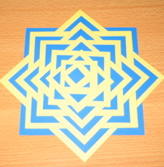Three boxes with three compartments each with:
-Three sets of equilateral triangles in red, blue, and yellow respectfully with the sides from 1cm to 10cm.
-Three sets of squares in red, blue, and yellow respectfully with the sides from 1cm to 10cm.
-Three sets of circles in red, blue, and yellow respectfully with the sides from 1cm to 10cm.

Invite a child to participate in the lesson. Have the child unroll a mat, then bring him over to the correct shelf. Show him the box and have him bring it over to the mat. Have the child place the box near the right side of the mat. Have the child sit near the left side of the mat and you sit to the child’s right.
Building
- Informally introduce the box to the child by giving the work’s name and showing the three layers of the box.
- Choose one layer to work with and from the layer, take out one of the three sets and place them randomly onto the mat (still on the right side of the mat).
- Close the box and move it to the top right corner of the mat.
- Grade the shape (for example the square) from largest to smallest but always keeping the same level for the base.
(As shown on the next page)
- Mix all ten of the one shape and have the child grade them just as was shown.
- Mix the ten of the shape again.
- Build the shapes in a grading manner but this time concentrically. (As shown below)
- Tell the child that they all have the same centers.
- Mix the shapes and have the child grade as was just shown,
- Show the child how to put them away by replacing it in the box but by keeping the bottom right corner of each shape in the bottom right corner of the box.
Exercises
Exercise 1
The child works individually with any of the shapes in the same manner as was shown during the presentation.
The child is shown how to work with two shapes at a time. This is very similar as when working with two shapes: Begin by building both by grading but one below the other. Then place every other of the two shapes concentrically. Then replace the two shapes in the box.
Exercise 3
The child is shown how to work with two shapes at a time but in a further manner than in Exercise 2. Begin by grading them both one below the other. Then place the largest of one of the shapes on top of the largest of the other shape. Repeat for every shape, always placing the next size down of one shape on the correct other shape. The child is then allowed to work with any other combination of two shapes. Here are a few examples of what the child may be able to create using two of the shapes.
 |
 |
 |
No language given with this material.
Direct
To further the child’s experience with shapes (plane figures).
Preparation for ornamental geometry.
Indirect
Preparation for understanding the relationship between plane figures.
Partly in the material (visual).
4 years


